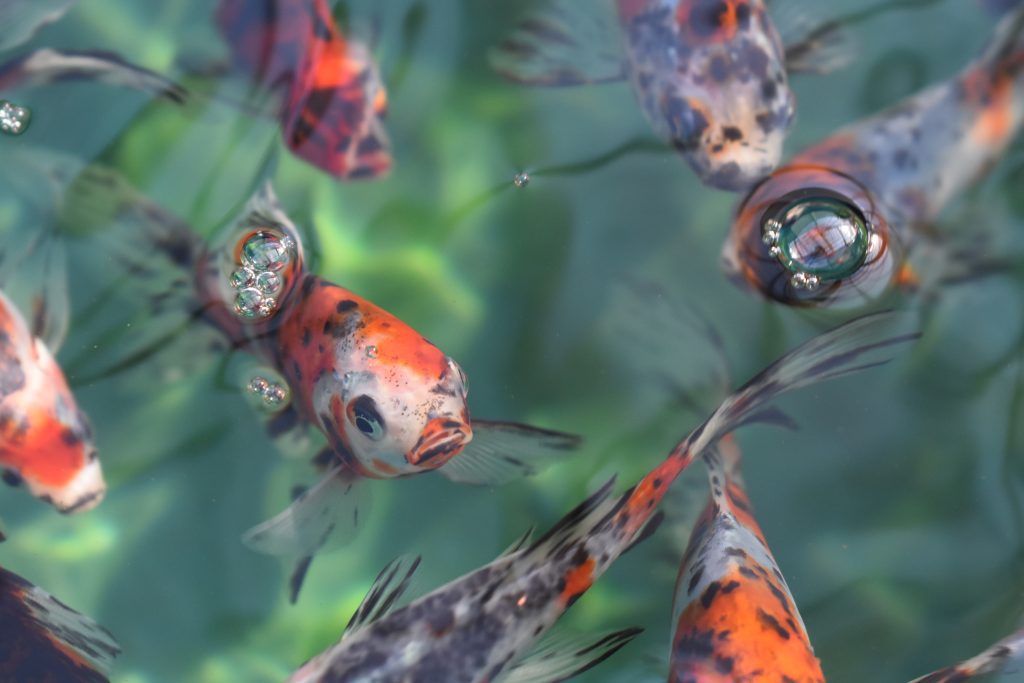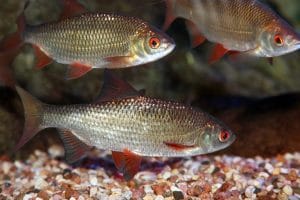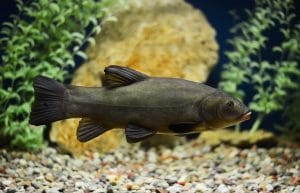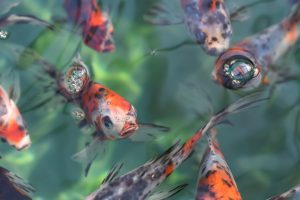
Goldfish Varieties - A Beginner's Guide to Goldfish: Exploring Popular Types for New Enthusiasts
Goldfish are popular pets that come in many exciting varieties. These colourful fish have been bred for centuries, resulting in a wide range of shapes, sizes, and colours.
There are over 125 different captive-bred goldfish varieties, each with unique features and care requirements.

From the classic orange Common Goldfish to the fancy Bubble Eye Goldfish, there’s a type to suit every taste.
Some goldfish have round bodies, while others are sleek and streamlined. Tail types vary too, from single tails to elaborate, flowing fins.
For beginners, hardy varieties like the Common Goldfish and Comet Goldfish are great choices.
These fish are easier to care for and can thrive in various environments.
As you gain experience, you might want to try more exotic types like the Black Moor or Chinese Lionhead.
Key Takeaways
- Goldfish come in over 125 varieties with different shapes, sizes, and colours.
- Common Goldfish and Comets are ideal for beginners due to their hardiness.
- Proper care, including a suitable tank and diet, is crucial for goldfish health and longevity.
The Evolution and History of Goldfish
Goldfish have a rich history spanning over a thousand years.
Selective Breeding Origins
Goldfish varieties emerged through careful breeding.
Ancient Chinese fish farmers noticed rare orange-gold carp in their ponds. They kept these fish separate and bred them.
Over time, they created fish with brighter colours and fancier fins. New shapes appeared too. Some had bulging eyes or round bodies. Others grew longer fins or forked tails.
Breeders picked the most striking fish to mate. This led to many unique types. Today, there are over 200 goldfish breeds. Each has its own special look.
Transition from Wild Carassius Auratus
Wild goldfish, known as Carassius auratus, are dull green or brown. They live in slow rivers and ponds in East Asia. These fish can survive in cold, low-oxygen water.
The first goldfish were mutations of this wild type. They stood out with their bright colour. People began to keep them as pets in the Song Dynasty (960-1279).
Goldfish spread to Japan in the 1500s, then to Europe in the 1600s. They became popular pets around the world. The fish adapted to life in small ponds and tanks. This helped them become one of the most common pet fish today.
Goldfish Classification by Tail Type
Goldfish come in many shapes and sizes, but their tails are a key feature for classification. Tail types fall into two main categories: single-tailed and fantailed varieties. Each type has distinct characteristics that affect the fish’s appearance and swimming ability.
Single-Tailed Varieties
Single-tailed goldfish have sleek bodies and long, flowing tails. These fish are excellent swimmers and need plenty of space to thrive.
The common goldfish is the most basic single-tailed variety, with a streamlined body and forked tail.
Comet goldfish are similar but have longer, more flowing fins. They’re known for their speed and agility in the water.
Shubunkin goldfish are another single-tailed type, notable for their calico colouration.
Single-tailed goldfish are hardy and well-suited for outdoor ponds. They can grow quite large, often reaching 30 cm or more in length. These varieties are better suited for spacious environments due to their active nature.
Fantailed Variants
Fantailed goldfish have a more rounded body shape and a split tail that resembles a fan.
The fantail goldfish is the most common of this type, with a short, egg-shaped body and a prominent tail.
These fish are slower swimmers compared to their single-tailed cousins. They come in various colours and patterns, including red, orange, and calico. Fantails are popular for aquariums due to their ornamental appearance.
Other fantailed varieties include the veiltail, with its long, flowing fins, and the ryukin, known for its high, humped back. These fish require more care as their elaborate fins can be prone to damage and disease.
Understanding Goldfish Varieties

Goldfish come in many shapes, colours, and sizes. Each type has its own special features and care needs. Let’s look at some popular goldfish breeds.
Fancy Goldfish
Fancy goldfish are known for their unique body shapes and fins. These fish often have round bodies and flowing tails. Fancy goldfish need special care due to their delicate fins and body shapes.
The Ranchu goldfish is a type of fancy goldfish with a round body and no dorsal fin. It has a curved back that looks like a lion’s mane.
Telescope goldfish have big, bulging eyes that stick out from their heads. These eyes can be fragile, so they need tanks with soft decorations.
Oranda goldfish are known for the fleshy growth on their heads called a wen. This wen can grow quite large and needs extra care to stay healthy.
Popular Goldfish Breeds
Common goldfish are hardy and great for beginners. They have slim bodies and can grow quite large in ponds.
Comet goldfish are similar to common goldfish but have longer, flowing tails. They are active swimmers and do well in large tanks or ponds.
Black Moor goldfish are a type of telescope goldfish with a velvety black colour. Their large eyes and dark colour make them stand out in any tank.
Shubunkin goldfish are known for their calico patterns. They come in a mix of orange, white, black, and blue colours.
These breeds each have their own charm and care needs. It’s important to research the specific breed you choose to keep.
Setting Up a Goldfish Aquarium

A proper goldfish aquarium setup is crucial for the health and happiness of your fish. The right tank size and filtration system are key elements to consider.
Choosing the Right Aquarium
Goldfish need a spacious tank to thrive. A 30 to 55-gallon aquarium is ideal for most goldfish varieties.
Avoid small bowls or tanks, as they don’t provide enough space for these active swimmers.
For single-tail goldfish like commons or comets, opt for a larger tank or even a pond. They grow quite large and need ample swimming room.
Fancy goldfish can do well in slightly smaller tanks, but still need at least 20 gallons for the first fish, plus 10 gallons for each additional fish.
Make sure the tank has a secure lid, as goldfish are known jumpers.
Essential Filtration Systems
A robust filtration system is vital for goldfish, as they produce a lot of waste.
Look for filters that provide mechanical, biological, and chemical filtration.
Canister filters are excellent for large tanks, offering powerful filtration and customisable media options. For smaller tanks, hang-on-back filters can be sufficient.
Aim for a filter that can process the entire tank volume at least 4 times per hour.
Goldfish thrive in well-oxygenated water, so consider adding an air pump and stone for extra aeration.
Regular maintenance of your filter is crucial. Clean or replace filter media as needed, but avoid changing all media at once to preserve beneficial bacteria.
Maintaining Optimal Water Conditions

Keeping goldfish healthy requires proper water management. Clean water and regular maintenance are essential for their well-being.
Water Quality and Parameters
Goldfish need specific water parameters for optimal health.
The ideal temperature range is 18-22°C. pH should be between 7.0 and 8.4.
Ammonia and nitrite levels must be 0 ppm. Nitrate should stay below 40 ppm. A reliable test kit helps monitor these values.
Hard water with 5-19 dGH is best for goldfish. They prefer slightly alkaline conditions.
Proper filtration is crucial. Choose a filter rated for at least twice the tank size. This helps remove waste and maintain water quality.
Oxygen levels are important too. Use an air pump or ensure surface agitation for good oxygenation.
Regular Water Changes
Goldfish produce a lot of waste, making frequent water changes necessary. Change 25-30% of the water weekly.
Use a gravel vacuum to remove debris from the substrate. This prevents harmful buildup.
Always treat tap water with a dechlorinator before adding it to the tank. Match the temperature of the new water to the tank water.
After water changes, check and adjust the pH if needed. Sudden changes can stress fish.
Consistency is key. Stick to a regular schedule for best results. This helps maintain stable conditions and reduces stress on the fish.
Goldfish Health and Diseases
Keeping goldfish healthy requires knowledge of common illnesses and proper preventative care. Recognising symptoms early and taking swift action can make a big difference in treating sick fish.
Common Illnesses and Treatments
Ich, also known as white spot disease, is a common goldfish ailment. It appears as tiny white spots on the fish’s body and fins. To treat ich, raise the water temperature gradually and use medication designed for parasites.
Fin rot causes frayed or discoloured fins. It’s often caused by poor water quality. Improve filtration and do partial water changes. Use antibiotics if needed.
Swim bladder disorder affects a fish’s buoyancy. Symptoms include floating sideways or upside down. Fast the fish for 2-3 days, then feed cooked peas to help clear the digestive system.
Preventative Care
Good fish care starts with proper tank maintenance. Change 10-20% of the water weekly and test water parameters regularly.
Feed a varied diet of quality fish food. Don’t overfeed, as this can lead to health issues.
Quarantine new fish for 2-4 weeks before adding them to an established tank. This helps prevent the spread of diseases.
Reduce stress by providing hiding spots and avoiding sudden changes in the tank environment. A calm, stable habitat boosts fish immunity.
Feeding and Nutrition
Proper nutrition is key for healthy goldfish. A balanced diet and good feeding habits help these fish thrive in captivity.
Understanding Goldfish Diets
Goldfish are omnivores and need a mix of plant and animal matter. Commercial flakes and pellets form the base of most goldfish diets. These foods contain the right balance of proteins, fats, and nutrients.
Variety is important. Offer different types of food to meet all nutritional needs. Some options include:
- Freeze-dried bloodworms or brine shrimp
- Blanched vegetables like spinach or lettuce
- Gel foods made for goldfish
Feed small amounts 2-3 times daily. This mimics natural grazing habits and reduces waste. Remove uneaten food after a few minutes to keep the water clean.
Supplemental Feeding Tips
Feed only what goldfish can eat in 1-2 minutes. Overfeeding leads to poor water quality and health issues. Adjust amounts based on fish size and activity level.
Sinking foods encourage natural foraging behaviour. This helps prevent swim bladder problems common in fancy goldfish varieties.
Consider these extra tips:
- Soak dry foods before feeding to aid digestion
- Offer live foods as occasional treats
- Use feeding rings to contain floating foods
- Fast fish one day per week to clear their digestive systems
Watch for signs of overfeeding like cloudy water or excess fish waste. Proper feeding habits keep goldfish healthy and tanks clean.
Goldfish Behaviour and Social Needs
Goldfish are social creatures with unique behavioural patterns. They thrive in groups and can interact with other fish species when kept in proper conditions.
Social Interactions Among Varieties
Goldfish are social fish that prefer to be in groups. They often swim together and engage in shoaling behaviour. This social nature applies to various goldfish varieties.
Different goldfish types can coexist peacefully. However, beginners should be cautious when mixing varieties. Some goldfish may have unique needs or temperaments.
Fancy goldfish, with their elaborate fins, might swim slower than common varieties. This can lead to feeding competition. It’s best to keep similar types together for harmonious interactions.
Goldfish communicate through body language and movements. They may follow each other, which helps in finding food and avoiding predators.
Choosing Compatible Tank Mates
When selecting tank mates for goldfish, size and temperament are crucial factors. Goldfish are generally peaceful community fish, but they can be boisterous eaters.
Larger fish species are often better companions for goldfish. This prevents the goldfish from attempting to eat smaller fish.
Good tank mates include:
- White Cloud Mountain Minnows
- Zebra Danios
- Rosy Barbs
Avoid aggressive or fin-nipping species. These can stress goldfish and damage their flowing fins.
When adding new fish, introduce them gradually. This helps reduce stress and allows for proper acclimation.
Remember, goldfish prefer cooler water temperatures. Choose tank mates that thrive in similar conditions for a successful community tank.
Breeding Goldfish and Genetic Considerations
Breeding goldfish requires careful planning and an understanding of genetic traits. Successful breeders focus on preparing ideal conditions and selecting fish with desirable characteristics to produce healthy offspring.
Breeding Preparation
Setting up a proper breeding tank is crucial for goldfish reproduction. The tank should be at least 75 litres and have a shallow area for egg-laying. Water temperature needs to be around 20°C, with good filtration and aeration.
Breeders should choose healthy adult fish, typically 2-3 years old. Feeding high-quality food rich in protein helps condition the fish for breeding. Some breeders use a technique called ‘spawning mops’ – synthetic fibres that mimic aquatic plants for egg attachment.
It’s important to separate male and female goldfish before breeding season. This helps increase their eagerness to spawn when reintroduced.
Genetic Traits and Selective Breeding
Goldfish breeding involves carefully selecting parent fish with desired traits. Breeders aim to enhance specific characteristics like colour, fin shape, or body type.
Common genetic traits in Carassius auratus include:
- Body shape (round, slender, egg-shaped)
- Fin types (single-tail, fantail, veiltail)
- Colouration (red, orange, black, calico)
- Eye types (normal, telescope, celestial)
Selective breeding requires patience and record-keeping. Breeders often use a method called ‘line breeding’, mating related goldfish to strengthen certain traits. However, this can also increase the risk of genetic defects.
It’s essential to cull fish with undesirable traits to maintain the quality of the breeding stock. Responsible breeders prioritise the health and welfare of their fish over aesthetic qualities.
Goldfish in Outdoor Ponds
Goldfish thrive in outdoor ponds, requiring specific conditions and care. Proper pond setup and maintenance are crucial for their health and longevity. Winter presents unique challenges for these cold-water fish.
Pond Requirements
Goldfish are hardy fish that adapt well to outdoor ponds. A suitable pond should be at least 50 gallons in volume and 2 feet deep. This depth allows fish to escape surface ice in winter.
Pond water quality is vital. Use a filter to remove waste and maintain oxygen levels. Test water regularly for pH, ammonia, and nitrites.
Plants are essential in goldfish ponds. They provide shelter, oxygenate water, and absorb excess nutrients. Water lilies, anacharis, and hornwort are excellent choices.
Choose pond-friendly goldfish varieties. Comets, Shubunkins, and Wakins are well-suited for outdoor living. Avoid fancy varieties with delicate fins or protruding eyes.
Winter Care for Cold-Water Fish
Goldfish can survive winter outdoors if the pond doesn’t freeze solid.
Stop feeding when water temperature drops below 10°C. Fish enter a state of dormancy and don’t require food.
Ensure the pond has a small ice-free area for gas exchange.
Use a pond de-icer or floating heater to maintain an opening. Don’t break ice, as shock waves can harm fish.
Remove fallen leaves and debris before winter. Decomposing matter can create toxic gases under ice.
Consider bringing fancy goldfish indoors for winter. They’re less cold-hardy than single-tailed varieties.
In spring, gradually resume feeding as water temperatures rise.
Monitor water quality closely as the pond ecosystem rebalances.



